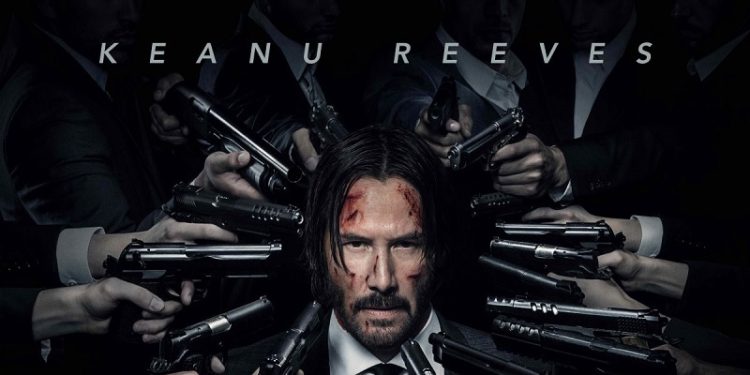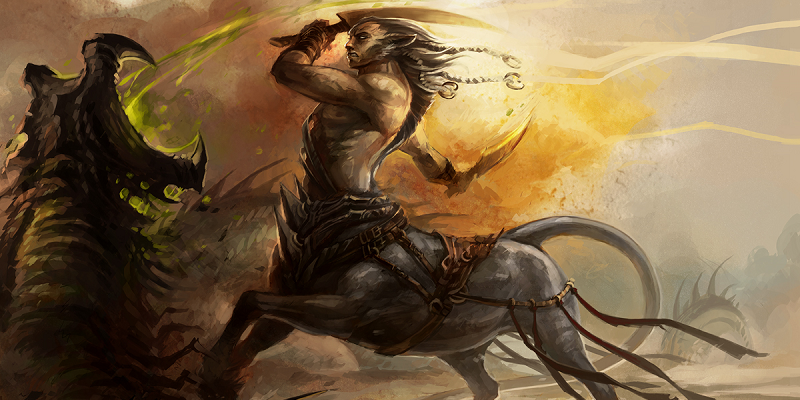John Wick and Mythology

This article possesses discussion and spoilers of John Wick and John Wick Chapter 2. I will avoid going into great detail, but it’s crucial to the discussion that I not avoid everything.
I had the distinct pleasure of seeing John Wick Chapter 2 this past weekend, and you know what? The series continues to have some of the best depictions of Hellenistic mythology I have ever seen. The film managed to expand the use of mythology, while maintaining the tone and style of the first film. I was leery of the continued expansion of the underworld first seen in John Wick, but it would appear my fears were unfounded. Not only was it handled well, the expansion was within the context of the established meta mythology the movie draws upon so deftly. I know a lot of people called out the Laurence Fishburne section of the film as one of the weaker points, but when viewed through the lens of the underlying mythology it becomes one of the more interesting set pieces. Regardless, what John Wick consistently does is use Hellenistic mythology to tell its own story, but one that would fit within the context of the original material. This is a phenomenal way to make things accessible, while still making it your own. In fact, I highly recommend this approach to running games.
Games walk a careful balance that movies do not need to worry about. While good movies immerse you in their world, you are there as an observer (except for when movies force perspective or make the viewer complicit in some way; this works and doesn’t, as you might expect). A good game engages you on multiple levels, and encourages the player to take action, rather than be a passive viewer. This does mean that the person running the game needs to firmly understand the tolerance levels of the players. All players come into a game with boundaries, and most are willing to expand those boundaries within the confines of their own comfort. Not everyone is the same, and not everyone is open to accept things far outside their initial boundaries. Spell-powered space barges piloted by British Imperialist hippos is just too much for some people, and the emotional angst of your deepest sins being used against you while you are within the mist-ridden lands of a powerful vampire might be too much for others. Thrusting players into those situations will rarely cause those boundaries to be expanded, even if the DM crafts an epic and amazing story. Instead, the more familiar the elements are, even on a subtle level, the more likely the players will engage. This is where the use of myths come in.

As I have mentioned before, John Wick is the best Nemesis story I have ever seen. In the first installment, we met Winston, the proprietor of the Continental Hotel, with the concierge named Charon. The Continental plays host to the criminal underworld, of course. In order for John Wick to delve into that world, he must first pay Charon gold coins to begin his journey. Let’s just call these drachmas. John Wick’s entire goal is to find and kill the man who stole his car and killed his dog, the gift from his dead wife. The perpetrator is the spoiled son of a Russian crime lord who wanted nothing more than to take what John possessed. He saw the car, John wouldn’t give it to him, and so he took it and the life of the dog. To John, this is everything he possessed in the world. Sure, he had his house, but his house was a place of self-imposed suffering. Iosef must then have the same fate visited upon him; those who get in the way must suffer, the way John has suffered because of Iosef’s actions. John Wick is not a good person by any stretch, but neither are the people he is visiting. An eye for an eye is very much the way this movie world works.
Marcus could easily be Chiron, the centaur trainer of heroes. Marcus trained John, and still considers John a friend and student. Marcus is a skilled sniper, shows loyalty in the face of obvious peril, and betrays a contract rather than kill his student. Of course, this betrayal ends in his death, as he knew it must, something that Viggo, the aforementioned crime lord, truly takes no pleasure in doing. Viggo is very much the Hector of Troy, as Iosef is Paris. Paris has taken everything John loved – his wife is even named Helen – and now Hector must defend his blood against someone who he knows has very real cause to bring violence. I digress; let’s get back to Marcus and Chiron.
Chiron is immortal, but exchanged his life for Prometheus’s so that mankind might have the gift of fire. This was the result of actions by Hercules, who caused Chiron’s death in the process of executing the plan to free Prometheus. As you can see, John fulfills multiple roles as the traditional tales play out, but the overarching theme of John as Nemesis is never lost despite this narrative shifting. It also allows seamless story transitions to occur, driven through John’s actions. John didn’t HAVE to choose to take these actions, but he is the personification of vengeance. Nemesis has no choice but to act, after all.

So enough of John Wick, and let us move on to John Wick Chapter 2. Here, we see the core of the story twined around the conceit of Orpheus. Orpheus takes to the underworld to retrieve his wife, and when he departs with her he is told he may leave on the condition he never looks back. He does, of course, and loses his wife forever. In this case, John is free from the underworld when he is given leave to build a life with Helen. This story is expanded upon in the second installment with the added detail that Santino D’Antonio, the son of a powerful crime lord, helped him escape and holds a marker. Now that John has “looked back”, Santino calls in the marker that John gave him for his previous favor. John refuses, only for Santino to burn his house to the ground, destroying even the memories of his wife – the picture, jewelry, and phone video that had been displayed several times throughout both films. Santino wants John to kill his sister Gianna for him so that Santino can take her place at the High Table. The High Table is quite obviously the Twelve Olympians.
This story of a female Olympian being removed for a male Olympian is yet another myth, that of Hestia and Dionysus. Hestia was the goddess of the hearth and the right ordering of domesticity and family. While modern tales have her peacefully stepping down to grant her place in Olympus to Dionysus, the older tales say no such thing. To add to this, Gianna is staging a coronation in some old ruins, where a rad rave is being held. You know, earth symbolism on top of the symbolism of a crumbling home. In a nod to the modern representation of the myth, Gianna chooses to take her own life rather than allow John to do it. John does shoot her in the head, because there had to be the proof John was involved in the death in order to fulfill the marker, but it is after Gianna bleeds out.
If you aren’t yet sold on this, Santino is attended by a woman named Ares. This is actually a funny misdirect. If anything, the Sommelier is actually the god of War, as he outfits John before his battle, shows a deep knowledge of weapons and John’s preferences, and anticipates what might be useful. Instead, the character Ares is actually Ariadne, Dionysus’s consort. Ariadne, you might remember, is given control of the labyrinth. The two places where we see the most of her is in the ruins, when Santino attempts to have his men kill John, and in the mirrored maze of the art museum that results in the final conflict between her and John. The labyrinth, when it was under the direction of Ariadne, required routine blood sacrifices. Suffice it to say, this movie made sure it had that in spades, beginning with Gianna as the womanly sacrifice, and all of the faceless minions as the others. There is also the implication that she has a sexual interest in John Wick. That, coupled with her failure, is something of the tale of Theseus and Ariadne.
When John returns with the sole purpose of killing Santino, we are treated to every assassin working to kill him. John survives, though injured, and he gives a drachma to a homeless man, with a request to see his boss. The homeless man provides him succor, and when John awakes, his wounds have been treated and he meets the Bowery King, Laurence Fishburne. The Bowery King has a network comprised of homeless people, and pigeons. He provides medical assistance and helps people travel throughout the city undetected. Yeah, he’s Hermes.

In case it wasn’t clear from the first film, Winston is absolutely Hades. Santino confronts Winston about his authority in the Continental, and it is referred to as Winston’s kingdom, while Winston also makes semi-disparaging comments about the High Table. If you forgot, Hades is not considered one of the Twelve Olympians, setting himself apart. The movie also ends with the reinforcing of the story of John as Orpheus as well as Nemesis. John spills blood on Continental ground, making him an outcast. He did not listen to the warning of Hades, and pays the price. Of course, the twist here is that Winston gives him a marker, as he did not want Santino to continue taking advantage of his hospitality and insulting him. Oh, Santino also has an extended discussion of his meal, solidifying his decadence in a Dionysian fashion.
If you look at everything I have discussed here, the message should be clear. This is not a single myth, but rather the remixing of several myths, with multiple characters having different roles. It’s right there for the interpretation, and the acknowledgement of the myths adds to the story rather than detracting from it. The story is its own, but draws heavily from well-known sources. It’s the telling of the story that makes it unique. I can’t stress enough how smart this is. There are enough touchpoints to draw people into the story, but they change the story with a different, visceral depiction. This is a great template for DMs to follow. It’s based in familiarity, but then provides avenues of growth and challenge.
There are hundreds of well-known myths out there. The average person knows enough of them to be able to discuss a couple of them at a relatively competent level. Thus, you have built in touchstones for your games, allowing players to anchor themselves with their existing knowledge while simultaneously paying attention to the twists the DM puts on them. It also allows the DM to heavily theme a game’s arc with little effort and lots of buy-in. The myths are almost never standalone stories, which allows the DM to chain things together, remix what needs to be remixed, and still end with something that has strong overtones of the original content.
In closing, I really can’t stress the importance of initial buy-in enough. Getting players to engage and stay engaged is what makes a game memorable and fun. There is still a trend of people being too cool for school in the gaming community. Finding ways to get those people invested is a huge problem, but one that myths can easily help out. Gilgamesh is an epic poem that has withstood the test of time for a reason. Icarus, Perdix, and Daedalus are there for the taking. I know it seems counter-intuitive to say that using these myths helps a story be unique, but it really does exactly that. Build upon the framework that has endured, and allow the players to get excited about the tale they undertaking. You will be surprised how positive of an impact this makes to your games.



